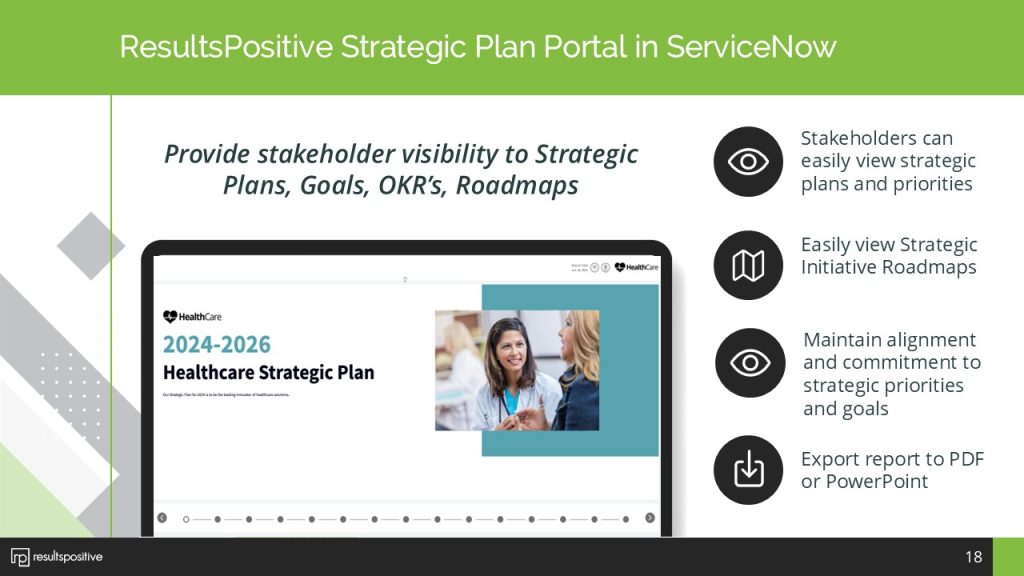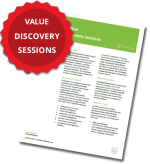ServiceNow Strategic Planning: A Beginner’s Guide to Success
Strategic planning is a critical process for organizations aiming to achieve long-term success. It involves setting a vision, aligning resources, and tracking progress toward meaningful goals. ServiceNow Strategic Planning is a robust module designed to streamline this process, helping businesses align their portfolios with their overarching objectives. Whether you’re new to ServiceNow or seeking to enhance your strategic approach, understanding the foundational principles is key to getting started.
We’ll explore the essential starting principles for effective strategic planning within ServiceNow. We’ll also highlight how the Strategic Plan Report (SPR) plugin can support each principle, offering practical tools to elevate your planning efforts.

The ServiceNow Strategic Plan Report plugin from ResultsPositive can help you streamline your planning processes.
Principle 1: Define Your Strategic Goals
The cornerstone of strategic planning is establishing clear, actionable goals. Without a well-defined destination, organizations risk drifting aimlessly, wasting time and resources. Strategic goals provide direction, aligning every department and initiative toward a shared purpose.
Why It Matters
Clear goals create focus. They help leaders prioritize efforts, allocate resources effectively, and communicate a unified vision to stakeholders. In ServiceNow, this step lays the groundwork for leveraging the platform’s capabilities to drive success.
How to Define Strategic Goals
-
Be Specific: Vague goals like “improve performance” lack clarity. Instead, aim for precision, such as “increase customer retention by 20% within two years.”
-
Align with Vision: Ensure goals reflect your organization’s mission and long-term aspirations.
-
Set a Timeline: Deadlines create urgency and accountability, such as “launch a new product line by Q3 next year.”
-
Involve Stakeholders: Engage key team members to ensure buy-in and feasibility.
For example, a company might set a goal to “expand into three new international markets by 2025, increasing global revenue by 15%.” This goal is specific, vision-aligned, and time-bound.
Defining goals isn’t just about brainstorming—it’s a structured process. Conducting a SWOT analysis (Strengths, Weaknesses, Opportunities, Threats) can uncover insights to shape your objectives. Regular workshops with leadership and cross-functional teams further refine these goals, ensuring they’re both ambitious and achievable.
How Our Plugin Can Help:
The Strategic Plan Report (SPR) plugin enhances this process by offering templates and frameworks within ServiceNow. It provides a centralized space to document goals, making them accessible to all stakeholders. Collaborative features allow teams to refine objectives together, ensuring alignment from the start.
Principle 2: Align Portfolios with Strategic Goals
With goals in place, the next step is ensuring your portfolios—groupings of projects, programs, and initiatives—support those objectives. Misaligned portfolios can drain resources and derail progress, making alignment a non-negotiable principle.
Why It Matters
Alignment ensures every project contributes to the bigger picture. It prevents wasted effort on low-impact initiatives and maximizes return on investment. In ServiceNow, portfolio alignment transforms strategic goals from abstract ideas into actionable outcomes.
How to Achieve Alignment
-
Map Projects to Goals: Link each initiative to a specific goal it supports. For instance, a project to upgrade IT infrastructure might tie to a goal of “improving operational efficiency.”
-
Prioritize High-Impact Work: Rank projects based on their strategic value, focusing resources on what matters most.
-
Review Regularly: Periodically assess alignment to catch and correct deviations early.
-
Eliminate Gaps: Identify areas where no projects support a goal and adjust accordingly.
Consider a business aiming to “enhance customer experience.” Alignment might involve prioritizing a CRM upgrade over a less relevant office renovation project. This deliberate focus keeps the portfolio on track.
Alignment isn’t static—it requires ongoing effort. Tools like weighted scoring models can help rank projects by strategic contribution, while stakeholder feedback ensures the portfolio reflects evolving priorities.
How Our Plugin Can Help:
The SPR plugin simplifies alignment with visual tools like matrices, showing how projects connect to goals. It flags misalignments or gaps, enabling quick adjustments, and centralizes portfolio data for easy review.
Principle 3: Set Measurable Objectives
Strategic goals are broad, but measurable objectives make them actionable. By breaking goals into quantifiable targets, organizations can track progress and maintain momentum. In ServiceNow, this principle bridges planning and execution.
Why It Matters
Measurable objectives provide clarity and accountability. They answer the question, “How will we know we’re succeeding?” Without them, progress remains subjective, and teams lose focus.
How to Set Measurable Objectives
-
Use Frameworks: Objectives and Key Results (OKRs) are a popular choice. An objective might be “boost employee satisfaction,” with key results like “increase engagement survey scores by 10 points in six months.”
-
Quantify Targets: Include numbers, percentages, or deadlines—e.g., “reduce support ticket resolution time by 25% this year.”
-
Ensure Achievability: Balance ambition with realism to keep teams motivated.
-
Link to Goals: Every objective should tie directly to a strategic goal.
For example, if a goal is “grow market presence,” objectives might include “launch two new ad campaigns by Q2” and “increase website traffic by 30% in nine months.” These targets are clear and trackable.
Setting objectives requires collaboration. Teams should agree on metrics and data sources—like ServiceNow’s Performance Analytics—to ensure consistency. Regular check-ins refine these targets as conditions change.
How Our Plugin Can Help:
The SPR plugin supports this by enabling OKR creation and tracking within ServiceNow. It links objectives to goals and portfolios, offering progress-monitoring tools to keep efforts on course.
Principle 4: Monitor and Adjust
Strategic planning isn’t a set-it-and-forget-it process—it demands continuous oversight. Monitoring progress and adjusting plans ensure your strategy remains relevant amid shifting priorities or external changes.
Why It Matters
Regular monitoring catches issues early, while flexibility allows adaptation to new challenges. In ServiceNow, this principle ensures your planning efforts deliver sustained value.
How to Monitor and Adjust
-
Schedule Reviews: Hold monthly or quarterly check-ins to assess progress.
-
Leverage Data: Use analytics to track KPIs tied to objectives, such as revenue growth or project completion rates.
-
Adapt Plans: Shift resources or revise goals based on performance data or market shifts.
-
Communicate Changes: Keep teams informed to maintain alignment.
Imagine a goal to “improve product quality.” If data shows defects rising despite new processes, a review might prompt additional training or a process overhaul. This proactive approach keeps the strategy alive.
Effective monitoring blends qualitative insights—like team feedback—with quantitative metrics. Scenario planning can also prepare you for potential disruptions, ensuring resilience.
How Our Plugin Can Help:
The SPR plugin aids this with dashboards and real-time reporting, offering insights into portfolio performance. Features like scenario modeling and alerts help you adjust strategies swiftly and confidently.
Getting Started
ServiceNow Strategic Planning empowers organizations to turn vision into action through four key principles: defining strategic goals, aligning portfolios, setting measurable objectives, and monitoring progress. These steps create a roadmap for success, ensuring every effort drives meaningful outcomes.
The Strategic Plan Report plugin from ResultsPositive enhances each principle with practical tools, from goal-setting templates to performance dashboards. While not the focus, its contributions streamline the process, making ServiceNow an even more powerful ally in your strategic journey.
Start with these principles, explore ServiceNow’s capabilities, and watch your organization thrive. Strategic planning is an ongoing commitment—embrace it, and the results will follow.










